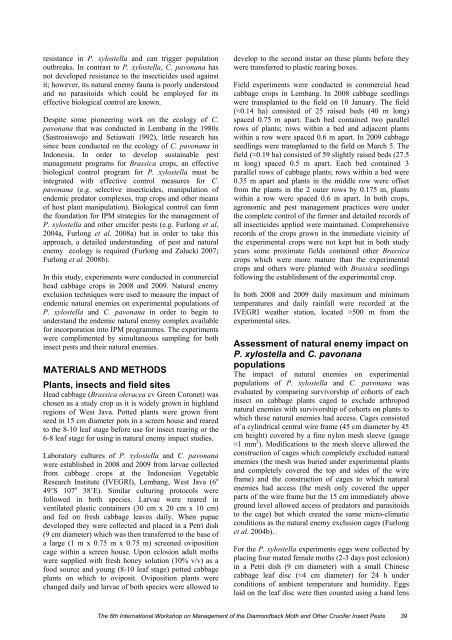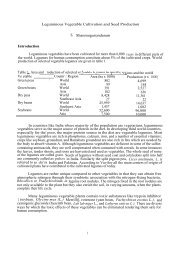Management of the Diamondback Moth and Other Crucifer Insect ...
Management of the Diamondback Moth and Other Crucifer Insect ...
Management of the Diamondback Moth and Other Crucifer Insect ...
Create successful ePaper yourself
Turn your PDF publications into a flip-book with our unique Google optimized e-Paper software.
esistance in P. xylostella <strong>and</strong> can trigger populationoutbreaks. In contrast to P. xylostella, C. pavonana hasnot developed resistance to <strong>the</strong> insecticides used againstit; however, its natural enemy fauna is poorly understood<strong>and</strong> no parasitoids which could be employed for itseffective biological control are known.Despite some pioneering work on <strong>the</strong> ecology <strong>of</strong> C.pavonana that was conducted in Lembang in <strong>the</strong> 1980s(Sastrosiswojo <strong>and</strong> Setiawati 1992), little research hassince been conducted on <strong>the</strong> ecology <strong>of</strong> C. pavonana inIndonesia. In order to develop sustainable pestmanagement programs for Brassica crops, an effectivebiological control program for P. xylostella must beintegrated with effective control measures for C.pavonana (e.g. selective insecticides, manipulation <strong>of</strong>endemic predator complexes, trap crops <strong>and</strong> o<strong>the</strong>r means<strong>of</strong> host plant manipulation). Biological control can form<strong>the</strong> foundation for IPM strategies for <strong>the</strong> management <strong>of</strong>P. xylostella <strong>and</strong> o<strong>the</strong>r crucifer pests (e.g. Furlong et al.2004a, Furlong et al. 2008a) but in order to take thisapproach, a detailed underst<strong>and</strong>ing <strong>of</strong> pest <strong>and</strong> naturalenemy ecology is required (Furlong <strong>and</strong> Zalucki 2007;Furlong et al. 2008b).In this study, experiments were conducted in commercialhead cabbage crops in 2008 <strong>and</strong> 2009. Natural enemyexclusion techniques were used to measure <strong>the</strong> impact <strong>of</strong>endemic natural enemies on experimental populations <strong>of</strong>P. xylostella <strong>and</strong> C. pavonana in order to begin tounderst<strong>and</strong> <strong>the</strong> endemic natural enemy complex availablefor incorporation into IPM programmes. The experimentswere complimented by simultaneous sampling for bothinsect pests <strong>and</strong> <strong>the</strong>ir natural enemies.MATERIALS AND METHODSPlants, insects <strong>and</strong> field sitesHead cabbage (Brassica oleracea cv Green Coronet) waschosen as a study crop as it is widely grown in highl<strong>and</strong>regions <strong>of</strong> West Java. Potted plants were grown fromseed in 15 cm diameter pots in a screen house <strong>and</strong> rearedto <strong>the</strong> 8-10 leaf stage before use for insect rearing or <strong>the</strong>6-8 leaf stage for using in natural enemy impact studies.Laboratory cultures <strong>of</strong> P. xylostella <strong>and</strong> C. pavonanawere established in 2008 <strong>and</strong> 2009 from larvae collectedfrom cabbage crops at <strong>the</strong> Indonesian VegetableResearch Institute (IVEGRI), Lembang, West Java (6 o49’S 107 o 38’E). Similar culturing protocols werefollowed in both species. Larvae were reared inventilated plastic containers (30 cm x 20 cm x 10 cm)<strong>and</strong> fed on fresh cabbage leaves daily. When pupaedeveloped <strong>the</strong>y were collected <strong>and</strong> placed in a Petri dish(9 cm diameter) which was <strong>the</strong>n transferred to <strong>the</strong> base <strong>of</strong>a large (1 m x 0.75 m x 0.75 m) screened ovipositioncage within a screen house. Upon eclosion adult mothswere supplied with fresh honey solution (10% v/v) as afood source <strong>and</strong> young (8-10 leaf stage) potted cabbageplants on which to oviposit. Oviposition plants werechanged daily <strong>and</strong> larvae <strong>of</strong> both species were allowed todevelop to <strong>the</strong> second instar on <strong>the</strong>se plants before <strong>the</strong>ywere transferred to plastic rearing boxes.Field experiments were conducted in commercial headcabbage crops in Lembang. In 2008 cabbage seedlingswere transplanted to <strong>the</strong> field on 10 January. The field(≈0.14 ha) consisted <strong>of</strong> 25 raised beds (40 m long)spaced 0.75 m apart. Each bed contained two parallelrows <strong>of</strong> plants; rows within a bed <strong>and</strong> adjacent plantswithin a row were spaced 0.6 m apart. In 2009 cabbageseedlings were transplanted to <strong>the</strong> field on March 5. Thefield (≈0.19 ha) consisted <strong>of</strong> 59 slightly raised beds (27.5m long) spaced 0.5 m apart. Each bed contained 3parallel rows <strong>of</strong> cabbage plants; rows within a bed were0.35 m apart <strong>and</strong> plants in <strong>the</strong> middle row were <strong>of</strong>fsetfrom <strong>the</strong> plants in <strong>the</strong> 2 outer rows by 0.175 m, plantswithin a row were spaced 0.6 m apart. In both crops,agronomic <strong>and</strong> pest management practices were under<strong>the</strong> complete control <strong>of</strong> <strong>the</strong> farmer <strong>and</strong> detailed records <strong>of</strong>all insecticides applied were maintained. Comprehensiverecords <strong>of</strong> <strong>the</strong> crops grown in <strong>the</strong> immediate vicinity <strong>of</strong><strong>the</strong> experimental crops were not kept but in both studyyears some proximate fields contained o<strong>the</strong>r Brassicacrops which were more mature than <strong>the</strong> experimentalcrops <strong>and</strong> o<strong>the</strong>rs were planted with Brassica seedlingsfollowing <strong>the</strong> establishment <strong>of</strong> <strong>the</strong> experimental crop.In both 2008 <strong>and</strong> 2009 daily maximum <strong>and</strong> minimumtemperatures <strong>and</strong> daily rainfall were recorded at <strong>the</strong>IVEGRI wea<strong>the</strong>r station, located ≈500 m from <strong>the</strong>experimental sites.Assessment <strong>of</strong> natural enemy impact onP. xylostella <strong>and</strong> C. pavonanapopulationsThe impact <strong>of</strong> natural enemies on experimentalpopulations <strong>of</strong> P. xylostella <strong>and</strong> C. pavonana wasevaluated by comparing survivorship <strong>of</strong> cohorts <strong>of</strong> eachinsect on cabbage plants caged to exclude arthropodnatural enemies with survivorship <strong>of</strong> cohorts on plants towhich <strong>the</strong>se natural enemies had access. Cages consisted<strong>of</strong> a cylindrical central wire frame (45 cm diameter by 45cm height) covered by a fine nylon mesh sleeve (gauge≈1 mm 2 ). Modifications to <strong>the</strong> mesh sleeve allowed <strong>the</strong>construction <strong>of</strong> cages which completely excluded naturalenemies (<strong>the</strong> mesh was buried under experimental plants<strong>and</strong> completely covered <strong>the</strong> top <strong>and</strong> sides <strong>of</strong> <strong>the</strong> wireframe) <strong>and</strong> <strong>the</strong> construction <strong>of</strong> cages to which naturalenemies had access (<strong>the</strong> mesh only covered <strong>the</strong> upperparts <strong>of</strong> <strong>the</strong> wire frame but <strong>the</strong> 15 cm immediately aboveground level allowed access <strong>of</strong> predators <strong>and</strong> parasitoidsto <strong>the</strong> cage) but which created <strong>the</strong> same micro-climaticconditions as <strong>the</strong> natural enemy exclusion cages (Furlonget al. 2004b).For <strong>the</strong> P. xylostella experiments eggs were collected byplacing four mated female moths (2-3 days post eclosion)in a Petri dish (9 cm diameter) with a small Chinesecabbage leaf disc (≈4 cm diameter) for 24 h underconditions <strong>of</strong> ambient temperature <strong>and</strong> humidity. Eggslaid on <strong>the</strong> leaf disc were <strong>the</strong>n counted using a h<strong>and</strong> lensThe 6th International Workshop on <strong>Management</strong> <strong>of</strong> <strong>the</strong> <strong>Diamondback</strong> <strong>Moth</strong> <strong>and</strong> O<strong>the</strong>r <strong>Crucifer</strong> <strong>Insect</strong> Pests 39
















